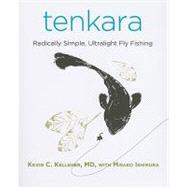
What is included with this book?
The New copy of this book will include any supplemental materials advertised. Please check the title of the book to determine if it should include any access cards, study guides, lab manuals, CDs, etc.
The Used, Rental and eBook copies of this book are not guaranteed to include any supplemental materials. Typically, only the book itself is included. This is true even if the title states it includes any access cards, study guides, lab manuals, CDs, etc.
The Tenkara Rod
Modern tenkara rods are technological wonders. Carbon-reinforced polymers have revolutionized tenkara. These rods are amazingly light, have a high strength-to-weight ratio, and have a telescoping package that allows for compact storage. Modern tenkara rods typically weigh two to four ounces, and are generally nine to fifteen feet long, with as many as eleven sections. The handle or grip contains the telescoping sections, allowing for easy transport. The remarkable collapsed package is only fourteen to twenty-four inches long, perfect for carry-on luggage or an ultralight backpack.
There are a surprising number of telescoping rods in Japan, each aimed at a specific type of fishing. However, a tenkara rod by definition has a grip, and its length is effectively limited to fifteen feet or less. The grip and length limitation are necessary to provide a light, balanced rod, which is comfortable for the repeated casting needed for all day fly presentation. Great care is taken to properly balance a tenkara rod.
Since tenkara rods have no reels, the line is attached at the tip. This may remind you of a cane pole, and, in many ways, a tenkara rod does reflect the cane pole’s simplicity. The grace and delicate presentation of the tenkara rod, however, supplied by its smooth application of power, far exceeds the cane pole or its poor cousins, the crappie pole and loop rod. The hollow, refined carbon modular components allow a transfer of force through the rod’s long lever arm, resulting in an almost effortless turning over of the line and fly. The rod actually becomes part of the flexing compound curve that turns over the line. Its tip, in the range of three hundredths of an inch (0.03"), is so flexible it becomes part of the cast. Indeed I have often said that the tenkara rod simply “launches a leader,” rather than a line.
Tenkara rods are rated by a ratio based on the number of stiff to supple sections. For instance, a 6:4 rod has six stiffer sections combined with four more flexible ones: the larger the ratio, the stiffer, or “faster,” the rod. When you “shake test” a tenkara rod, this ratio will predict the point of maximum flex. But keep in mind that the tenkara rod, particularly because of its length, is slower than traditional fly rods. This makes it ideal for short and delicate presentations.
A standardized method of describing a fly rod’s action in its entirety has not yet been devised. The “Common Cents System” [1] is perhaps the most useful. When you choose your rod, remember that tenkara rods do not describe the same kind of compound curve as do fly rods. The so-called “action angle” is of little use in describing their speed. More useful, the ERN values (Effective Rod Number) that correspond to the weight of line in the western system roughly correlate with the “stiffness” of the tenkara rod. Measurements of a sampling of tenkara rods correspond with western rods, from a one-weight all the way to a six-weight rod. I prefer rods at the softer (lower) end for their ease in casting. A stiffer (higher) rod has the ability to manage larger fish but tends to need a bit more muscle in casting. For now, test casting a tenkara rod is the best way to match your particular sensibilities and style.
One particularly ingenious innovation of the modern tenkara rod is in its telescoping grip storage. This compact storage makes for one of the smallest packages in fishing even while creating one of the longest reaches. With a simple unscrewing of the butt cap, all the pieces can be removed for cleaning and easily and inexpensively replaced if damaged. When extending or collapsing your tenkara rod, be sure to push and pullin-linewith the long axis; most damage occurs when collapsing the rod. Make sure the sections are snug, ensuring a smooth action, but don’t over tighten. Cleaning your rod from time to time with a soft cloth and drying it after a day on the stream is always a good idea, and can make for a nice, mindful conclusion to a fishing excursion. Gear readiness also makes your next spontaneous outing more likely. Lightly waxing the joining sections can aid the fit, making telescoping in freezing weather easier.
[1] Hanneman, William, http://www.common-cents.info/.